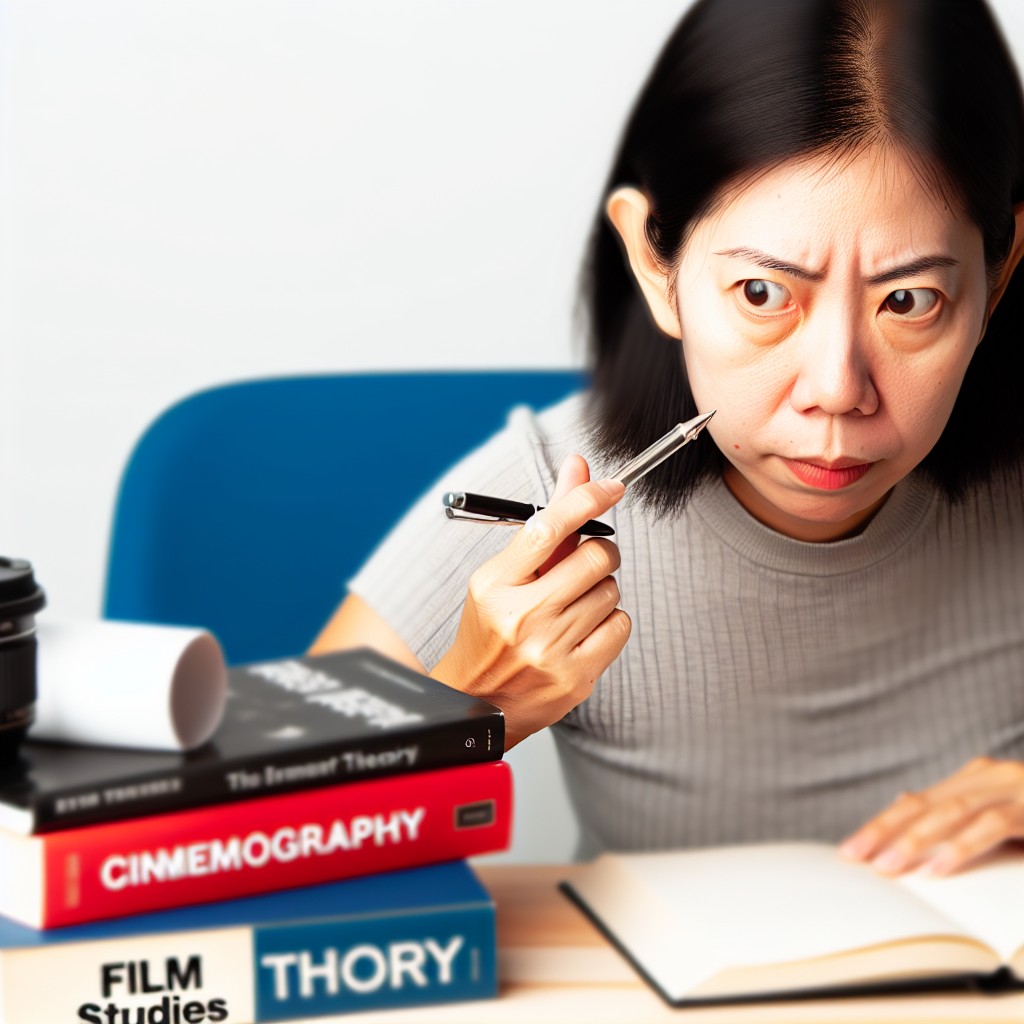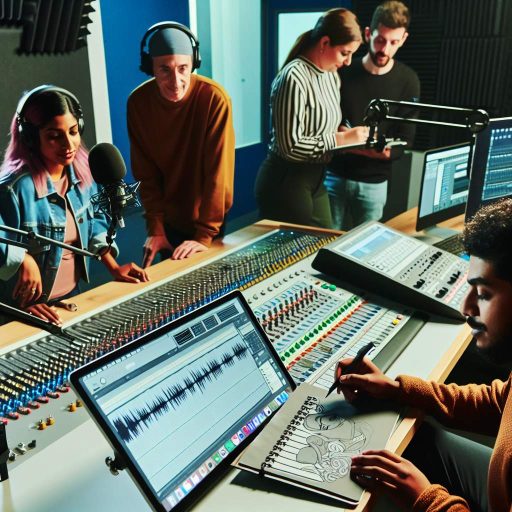Introduction
Film theory serves as a lens through which we analyze and interpret films.
It enhances our understanding of cinema’s artistic and cultural significance.
Critics use this knowledge to evaluate films beyond surface-level enjoyment.
By applying various theoretical frameworks, they uncover deeper meanings and narratives.
Many elements are fundamental to film theory.
First, semiotics explores signs and symbols within films.
Understanding how images convey meaning is crucial for critics.
Second, narrative structure examines how stories unfold on-screen.
This aspect includes analysis of plot, character development, and pacing.
Another essential element is genre theory.
It categorizes films into distinct genres, each with unique conventions.
Critics need to recognize these conventions to assess a film’s effectiveness.
Additionally, historical context plays a critical role.
A film’s creation is often influenced by the social and political climate of its time.
Critics should also familiarize themselves with auteur theory.
This approach emphasizes the director’s role as the film’s creative force.
It allows critics to recognize individual style and thematic consistency across works.
Similarly, ideological analysis examines the underlying messages in films.
Critics can dissect the values and beliefs that shape narratives.
Moreover, formalism focuses on a film’s visual and auditory elements.
Transform Your Career Today
Unlock a personalized career strategy that drives real results. Get tailored advice and a roadmap designed just for you.
Start NowThis includes cinematography, editing, sound design, and mise-en-scène.
Critics should appreciate how these components work together to create meaning.
Audience reception theory is yet another vital consideration.
Understanding how viewers interpret a film adds depth to criticism.
Film theory enriches film criticism significantly.
By engaging with various theoretical frameworks, critics can offer profound insights.
Awareness of these elements enables more robust discussions about films.
This understanding may enhance both critical writing and the viewing experience itself.
The Basics of Film Theory
Film theory serves as a foundational tool for understanding cinema.
It encompasses a range of ideas and concepts that help viewers interpret films.
By studying film theory, critics and audiences gain deeper insights into the art of filmmaking and storytelling.
This analysis aids in the exploration of complex themes, narratives, and visual styles.
Definition and Purpose of Film Theory
Film theory can be defined as the study of the principles and methods behind film creation and interpretation.
Its primary purpose involves analyzing how films convey meanings, emotions, and themes.
Film theorists examine the components that contribute to the viewer’s experience.
Consequently, they focus on the mechanisms that filmmakers use to craft their narratives.
The exploration of film theory helps critics and enthusiasts articulate their thoughts on cinema.
This process enables a richer dialogue about films and fosters a deeper appreciation of the medium.
By employing various theoretical frameworks, critics evaluate films from different angles.
Showcase Your Business Today
Reach thousands of readers actively exploring professional services. Publish your business profile and grow your audience now.
Publish NowThis multifaceted examination proves valuable for understanding the complexity of the cinematic experience.
Main Components of Film Theory
Several key components comprise film theory.
Understanding these elements is essential for a comprehensive analysis of any film.
The following components often come into play:
- Narrative Structure
- Cinematography
- Editing Techniques
- Sound Design
- Genre Studies
- Ideological Critique
Narrative Structure
Narrative structure refers to how a story is organized within a film.
It involves the arrangement of events and character development.
This structure typically features an introduction, rising action, climax, falling action, and resolution.
Understanding narrative techniques allows critics to explore themes more effectively.
Three-act structures often dominate mainstream cinema.
However, filmmakers frequently experiment with nonlinear narratives.
Examples include films that utilize flashbacks or multiple timelines.
These narrative choices create opportunities for deeper engagement and analysis.
Cinematography
Cinematography encompasses the visual aspects of a film.
This component includes shot composition, lighting, camera movement, and framing.
Cinematographers use these tools to create mood and atmosphere.
The visual style of a film not only enhances storytelling but also influences viewer emotions.
Critics consider how colors, angles, and movement contribute to a film’s meaning.
For example, a low-angle shot often conveys power.
Conversely, a high-angle shot may suggest vulnerability.
By understanding these visual techniques, viewers decipher the film’s underlying messages more effectively.
Editing Techniques
Editing shapes the flow and pacing of a film.
This aspect manipulates how scenes transition from one to another.
Editors employ various techniques, such as cuts, fades, and dissolves, to control narrative rhythm.
Proper editing enhances storytelling by establishing tension and maintaining viewer interest.
Montage serves as a pivotal editing technique in film.
It allows the juxtaposition of images to convey a larger idea or emotional response.
Furthermore, continuity editing strives to provide a seamless viewing experience.
By analyzing editing techniques, critics uncover the intricacies of how narratives unfold on screen.
Sound Design
Sound design includes dialogue, music, and sound effects.
It plays a crucial role in creating a film’s atmosphere.
Sound enhances emotional depth and aids in storytelling.
For instance, a haunting musical score can evoke fear.
Meanwhile, uplifting music connects viewers to moments of joy.
Furthermore, sound design can manipulate audience perception.
The placement of sounds, such as whispers or echoes, can create tension.
Critics analyze how these auditory elements contribute to the narrative.
Thus, sound design proves indispensable in film theory.
Genre Studies
Genre studies examine the conventions and expectations associated with specific film genres.
Each genre possesses unique characteristics, themes, and stylistic elements.
Understanding these conventions helps critics interpret a film within its genre context.
Showcase Your Business Today
Reach thousands of readers actively exploring professional services. Publish your business profile and grow your audience now.
Publish NowFor instance, horror films commonly utilize suspenseful music and abrupt editing.
Conversely, romantic comedies generally emphasize lighter tones and comedic timing.
Critics analyze how filmmakers adhere to or subvert genre conventions.
This process provides insight into cultural and societal influences reflected in cinema.
Ideological Critique
Ideological critique involves analyzing a film’s underlying beliefs and values.
This component considers how films reflect, reinforce, or challenge societal norms.
Critics often examine issues such as representation, gender, race, and class.
By identifying these ideological elements, critics uncover the socio-political implications of a film.
Moreover, ideological critique can illuminate the filmmaker’s perspective.
Understanding how filmmakers position their narratives helps viewers critically engage with content.
This analysis extends beyond mere entertainment, inviting deeper discourse on pressing societal issues.
Exploring Film Theory’s Impact
Understanding the basics of film theory enriches film analysis.
The interplay between narrative structure, cinematography, editing techniques, sound design, genre studies, and ideological critique enables critics to explore films more profoundly.
Each component contributes uniquely to the overall cinematic experience.
This multifaceted approach allows viewers to appreciate films at a deeper emotional and intellectual level.
By engaging with film theory, critics and audiences create a richer dialogue around cinema.
The exploration of these concepts not only fosters appreciation for filmmaking artistry but also encourages critical conversations about the narratives we consume.
Ultimately, film theory serves as a vital framework for understanding the intricate world of cinema.
Key Approaches in Film Theory
Film theory offers various approaches to analyze and appreciate cinema.
Different methods provide unique lenses through which critics assess films.
Critics can deepen their understanding by using these approaches.
This section will explore three significant film theories: auteur theory, genre theory, and feminist film theory.
Auteur Theory
Auteur theory centers on the director as the film’s primary creative force.
This approach assumes that the director’s vision significantly influences a film’s aesthetic and thematic elements.
Critics often look for recurring motifs, styles, and themes in a director’s body of work.
Key Features of Auteur Theory
- The director is considered the “author” of the film.
- Similar stylistic traits often appear across a director’s films.
- Recurring themes highlight a director’s personal philosophy.
- Focus on individual creativity rather than collaborative efforts.
- Critics assess how personal experiences shape a director’s work.
Critics using auteur theory may focus on films by directors like Alfred Hitchcock or Quentin Tarantino.
They examine Hitchcock’s suspense techniques and recurring themes of obsession and guilt.
They analyze Tarantino’s unique narrative structure and dialogue style.
By understanding the auteurs, critics appreciate the personal touches that enhance storytelling.
Genre Theory
Genre theory categorizes films based on shared characteristics.
This approach focuses on conventions and expectations associated with specific genres.
Critics analyze how films conform to or deviate from established genre norms.
Key Features of Genre Theory
- Classifies films into genres like horror, comedy, drama, and action.
- Investigates genre conventions, such as tropes and motifs.
- Explores how films challenge or reinforce genre expectations.
- Considers historical and cultural contexts of genres.
- Examines audience reception and genre popularity.
Critics employing genre theory frequently analyze horror films.
They may discuss how a film follows traditional tropes like jump scares and the final girl archetype.
They explore innovative films like “The Cabin in the Woods,” which subverts expectations.
Such critiques reveal how genre conventions convey deeper cultural meanings.
Feminist Film Theory
Feminist film theory critiques representations of gender in cinema.
This approach examines how films portray women and challenge patriarchal norms.
Feminist critics aim to highlight power dynamics and gender inequalities in film narratives.
Key Features of Feminist Film Theory
- Analyzes female representation and agency in film.
- Critiques male gaze and objectification of women.
- Explores films that empower female characters.
- Investigates interactions between gender, class, and race.
- Discusses the impact of women’s narratives on cinema.
Critics utilizing feminist film theory examine films like “Thelma & Louise.”
Showcase Your Business Today
Reach thousands of readers actively exploring professional services. Publish your business profile and grow your audience now.
Publish NowThey celebrate its portrayal of female friendship and independence.
Critics also analyze how the film critiques societal norms.
This approach encourages critics to consider the broader implications of gender representation.
They strive for a more inclusive understanding of narratives.
The Influence of Film Theory on Criticism
Each approach in film theory profoundly influences how critics analyze a film.
By adopting a specific framework, critics gain new insights.
They can uncover layers of meaning and context.
These approaches allow for a more enriched discussion of cinematic experiences.
How Each Approach Shapes Analysis
- Auteur theory: Enhances appreciation of a director’s vision and stylistic choices.
- Genre theory: Provides a framework for understanding conventions and audience expectations.
- Feminist film theory: Challenges traditional narratives and highlights gender representation.
Critics often combine several theories for a nuanced analysis.
They might explore a film’s genre while considering the director’s unique touch.
They could also examine gender dynamics within various genre constraints.
This method heightens critical discourse and enriches the conversation around cinema.
Discover More: Career Pathways in Sports Announcing
What is Semiotics?
Semiotics is the study of signs and symbols and their use or interpretation.
It emerged primarily from linguistics.
This discipline explores how meaning is created and conveyed through various forms.
In film theory, semiotics plays a crucial role in understanding how audiences interpret narratives and visuals.
The Importance of Semiotics in Film
Semiotics is fundamental in film for several reasons:
- Understanding Meaning: It helps analyze how meaning is constructed in visual narratives.
- Audience Interpretation: It examines how viewers interpret signs in films.
- Conveying Ideas: Films use symbols and codes to express complex ideas succinctly.
- Enhancing Narrative: It enriches the narrative by deepening the analysis of visual storytelling.
Signs and Their Functions
In semiotics, a sign is anything that communicates a meaning.
This could be an image, sound, or gesture.
Signs consist of two components:
- Signifier: This is the form that the sign takes, such as a word or image.
- Signified: This refers to the concept or meaning that the sign represents.
Films utilize signs to trigger specific interpretations.
For example, a red traffic light signifies “stop,” while a green light means “go.”
This simplicity allows filmmakers to utilize signs effectively, guiding audience perception and emotion.
Symbols in Film
Symbols are a special type of sign that represent broader concepts.
They carry deeper meanings beyond the literal interpretation.
In film, symbols can evoke emotional responses and connect with cultural contexts.
Consider a few examples:
- The Rose: Often symbolizes love or passion in various films.
- Water: Frequently represents life, rebirth, or cleansing.
- Mirrors: May symbolize reflection, identity, or duality.
Filmmakers select symbols carefully.
They know audiences can associate them with various themes or emotions.
Through repetition, these symbols create a shared understanding among viewers.
Codes and Their Role in Narrative
Codes are systems of signs that create meaning within a specific context.
In film, codes guide viewers by establishing expectations.
These can be technical, cultural, or genre-based.
Examples include:
- Technical Codes: Camera angles, lighting, and editing techniques shape a film’s visual language.
- Cultural Codes: Societal norms and values influence how narratives are perceived in different cultures.
- Genre Codes: Specific conventions help define genres, such as horror, romance, or action.
Each code enhances how viewers engage with a film.
It sets up anticipations that make the viewing experience more dynamic and informed.
Interpreting Meaning through Context
The meaning generated through semiotics in film relies heavily on context.
The same sign can convey different meanings based on various factors:
- Cultural Context: Audiences interpret symbols based on their cultural backgrounds.
- Historical Context: The time period influences perceptions of signs and symbols.
- Personal Context: Individual experiences shape how a viewer responds to a film.
Understanding context enriches the semiotic analysis of film.
Showcase Your Business Today
Reach thousands of readers actively exploring professional services. Publish your business profile and grow your audience now.
Publish NowIt enables critics to decipher layered meanings and engage deeply with the narrative.
Case Studies of Semiotics in Film
Analyzing specific films provides insight into how semiotics operates.
Let’s examine a few notable examples:
- Inception (2010): This film employs various signs to convey dreams’ complexity. The spinning top serves as a vital symbol of reality versus dream.
- The Godfather (1972): The recurring motif of oranges symbolizes impending doom. This code generates tension, foreshadowing critical plot twists.
- Schindler’s List (1993): The girl in the red coat stands as a poignant symbol amidst the film’s bleakness. This use of color contrasts reveals innocence lost.
These films demonstrate the power of signs, symbols, and codes.
Filmmakers leverage semiotics to craft emotionally resonant stories.
Appreciating the Art of Visual Storytelling
Understanding semiotics enhances our appreciation of film as a rich storytelling medium.
By examining signs, symbols, and codes, viewers unlock layers of meaning.
This exploration allows audiences to connect more profoundly with narratives.
Semiotics reveals how films encapsulate complex ideas and cultural commentary.
Ultimately, it equips critics with tools to analyze films effectively and appreciate the art of visual storytelling.
You Might Also Like: Film Producers: Navigating Industry Regulations
Understanding Film Form and Style
Understanding film form and style is essential for analyzing any movie.
Filmmakers shape a film’s narrative through various formal elements.
Among these are mise-en-scène, sound, and editing.
Each element holds tremendous power to evoke emotions and convey themes.
Mise-en-scène
Mise-en-scène refers to everything visible within a frame.
It encompasses several components:
- Setting: The location and time period influence the film’s mood and theme.
- Costume and Makeup: Characters’ outfits and appearances reveal their personality and social status.
- Lighting: The use of light shapes the viewer’s perception of mood and action.
- Spatial Composition: The arrangement of actors and objects strengthens the narrative and creates visual balance.
- Performance: Actors’ delivery of lines and actions engages or distances viewers.
Filmmakers meticulously craft mise-en-scène to guide the audience’s experience.
For instance, a dark, cluttered setting might evoke feelings of claustrophobia or anxiety.
In contrast, an open, bright space could symbolize freedom or hope.
The choice of colors also plays a central role.
Consider the use of color.
Warm colors might evoke feelings of passion and excitement, while cool colors could suggest sadness or tranquility.
By manipulating various aspects of mise-en-scène, filmmakers can create a solid emotional foundation for audiences.
Each element weaves a visual tapestry that supports the film’s themes.
Sound
Sound is another essential element of film form.
Multiple components contribute to the overall auditory experience:
- Dialogue: The spoken words convey character relationships and motivations.
- Sound Effects: These enhance reality and create suspense or surprise.
- Music: A powerful score can evoke emotions and set the tone.
- Silence: Used strategically, silence can amplify tension or highlight a pivotal moment.
Filmmakers use sound to manipulate viewers’ emotions.
For example, a haunting score may evoke feelings of dread during a horror film.
Conversely, uplifting music in a romantic scene can enhance joy and optimism.
Sound effects also play a vital role.
The sound of creaking doors or distant thunder can build anticipation and suspense.
These auditory elements work in concert to create layers of meaning and emotional resonance.
Editing
Editing connects scenes and influences pacing.
It shapes how a narrative unfolds through techniques such as:
- Cuts: Quick cuts can create excitement, while longer takes can encourage reflection.
- Transitions: Fades, dissolves, and wipes can signal shifts in time or reality.
- Montage: A series of rapid images can condense time or highlight themes.
- Parallel Editing: Juxtaposing separate storylines can create tension and complexity.
The choice of editing styles impacts audience engagement.
Fast-paced editing in action sequences can generate adrenaline.
In contrast, slower edits provide time for emotion to resonate.
Editing choices can also reveal character psychology.
For instance, a fragmented editing style might illustrate a character’s mental state.
Showcase Your Business Today
Reach thousands of readers actively exploring professional services. Publish your business profile and grow your audience now.
Publish NowBy carefully structuring a narrative through editing, filmmakers can guide audience interpretation and emotional involvement.
Combined Effects of Form and Style
Filmmakers harmoniously combine mise-en-scène, sound, and editing.
This combination reinforces themes and evokes emotions.
For example, in a film about loss, a dimly lit space (mise-en-scène) paired with a melancholic score (sound) and slow editing (editing) can profoundly impact viewers.
Consider how a film may portray a transformative journey.
Bright lighting, lively music, and rapid cuts during moments of growth can evoke joy.
Using contrasting elements in climactic scenes deepens emotional complexity.
Using dark settings and heavy dialogue can express despair.
The interplay of these elements results in a rich, layered viewing experience.
Impact on Narrative
The elements of film form and style significantly impact narrative delivery.
They offer insight into character motivations and broader themes.
By analyzing how these components function together, viewers gain a deeper understanding of a film’s meaning.
Mise-en-scène often emphasizes the emotional state of characters.
For example, a character isolated in a vast landscape suggests loneliness.
Additionally, sound can enhance internal conflicts, revealing characters’ struggles through dialogue or music.
Often, moments of silence speak volumes in conveying a character’s turmoil.
Editing choices further highlight narrative threads.
They control the pacing of emotional arcs.
Clarity in editing can ensure that crucial themes resonate with viewers.
Disjointed editing may mirror a character’s disorientation, reflecting their struggles in the narrative.
Implications for Film Analysis
In analyzing film form and style, it is crucial to recognize the intricate relationship between elements.
Mise-en-scène, sound, and editing contribute uniquely to a film’s narrative.
Understanding these components strengthens critical analysis and appreciation of cinema.
By examining how filmmakers use these elements, viewers can engage more deeply with films.
This engagement allows for a richer experience, fostering greater emotional and intellectual connections.
Embracing film theory enhances our understanding of art and its power to shape narratives and evoke feelings.
Discover More: Developing a Comprehensive SEO Audit Checklist

The Influence of Ideology on Film Reception
Ideology significantly impacts how audiences interpret films.
Audiences bring their beliefs, values, and cultural backgrounds to the viewing experience.
These elements color their understanding of a film’s themes and messages.
- Personal Beliefs: Viewers’ personal convictions can shape their reception of a film.
- Cultural Context: Cultural backgrounds also inform viewers’ interpretations.
- Historical Background: Knowledge about historical circumstances can influence understanding.
- Social Issues: Films that tackle pressing social issues can resonate differently based on audience perspectives.
The Power of Filmmakers to Shape Ideological Narratives
Filmmakers wield considerable power in shaping the ideology within their films.
They can choose to reinforce or challenge dominant ideologies, impacting audience perspectives significantly.
- Reinforcing Dominant Ideologies: Many filmmakers align their work with prevailing social norms.
- Challenging Established Norms: Other filmmakers aim to challenge societal status quos.
- Subtext and Symbolism: Artists often employ subtext and symbolism to convey deeper ideological messages.
- Character Representation: Filmmakers construct characters that either embody or contest prevailing values.
Examples of Ideological Manipulation in Films
Historical and contemporary films provide numerous instances of how ideology operates within cinematic narratives.
- Selfie (2019): This film engages with social media’s role in shaping identity.
- Parasite (2019): This film captures class struggle and economic disparity in South Korea.
- Get Out (2017): Jordan Peele’s horror film tackles racial tensions and the concept of cultural appropriation.
- Mad Max: Fury Road (2015): This film features a strong feminist message.
Ideology in Genre Films
Genre plays a crucial role in how filmmakers convey ideological messages.
Different genres offer specific conventions that can either support or subvert dominant ideologies.
- Science Fiction: Often examines future possibilities, questioning ethical dilemmas.
- Horror: Frequently reflects societal fears and anxieties.
- Romance: Often reinforces traditional relationship norms and ideals.
- Documentary: Conveys ideological perspectives by presenting real events and issues.
The Role of Audience Reception in Ideology
Audience reactions to films can significantly inform the ideological landscape.
Each viewer’s perspective can transform the impact of a film’s message.
- Critical Engagement: Active viewers analyze films critically.
- Community Discussions: Film viewing often leads to collective discussions among peers.
- Social Media Impact: Online platforms amplify audience voices.
- Contextual Interpretation: Individual contexts affect how a viewer interprets a film.
Exploring the Interaction of Film and Ideology
Understanding this dynamic interaction enriches the film exploration experience.
It encourages deeper engagement with all forms of cinema.
Recognizing ideology in films allows for a broader appreciation of the art form.
Showcase Your Business Today
Reach thousands of readers actively exploring professional services. Publish your business profile and grow your audience now.
Publish NowIt highlights its societal implications.
You Might Also Like: Essential Tips for Conducting Live Radio Shows
Film theory offers critics a structured framework for analyzing movies.
By grounding critiques in established theories, critics gain a deeper understanding of the films they discuss.
This section explores how to effectively apply film theory in criticism, highlighting its significance and providing practical examples.
We categorize the application into several key film theories, each providing unique insights.
Cinematic Language
Critics often begin their analysis with cinematic language, the vocabulary of film that includes visual and auditory components.
Understanding this language enables critics to dissect how films communicate messages.
For instance:
- Camera Angles: Analyzing the significance of high-angle shots versus low-angle shots can reveal power dynamics in a scene. A low-angle shot may depict a character as strong or dominant.
- Editing Techniques: Critics assess the pacing of edits. Quick cuts can create tension, while long takes can encourage reflection. Examining these can reveal the filmmaker’s intent.
- Sound Design: Using diegetic and non-diegetic sound adds layers to the narrative. Critics can explore how sound influences viewer emotions and expectations.
Narrative Structure
Film narratives often follow established structures, such as the three-act structure or nonlinear narratives.
Critics can analyze how these structures affect storytelling.
Here are some examples:
- Three-Act Structure: Many films employ this structure to build tension and deliver satisfying resolutions. Critiques can evaluate how effectively a film adheres to or subverts this format.
- Nonlinear Narratives: Films like “Pulp Fiction” challenge audiences with disordered timelines. Critics should assess how this approach impacts the audience’s engagement and understanding.
- Character Arcs: Understanding a character’s journey enhances critique quality. Critics can analyze how transformations reflect thematic elements and resonate with audiences.
Genre Theory
Genre theory provides a lens through which to examine the conventions and expectations associated with different film categories.
Using genre theory allows critics to evaluate how well a film conforms to or deviates from genre norms:
- Horror: Critics often analyze how a horror film utilizes tropes like jump scares or atmospheric tension. They can explore how these choices impact viewer experience.
- Romantic Comedy: Expectations for romantic comedies include meet-cutes and happy endings. Critics can assess whether a film employs these elements effectively.
- Documentary: Analyzing the representation of reality in documentaries can reveal biases. Critics can discuss how filmmakers shape narratives through selective storytelling.
Historical and Cultural Context
Understanding a film’s historical and cultural background enriches critiques.
Film theory encourages critics to consider how context influences cinematic choices.
Here are several angles:
- Social Commentary: Many films reflect social issues relevant to their release period. Critics can connect themes to societal contexts, revealing deeper meanings.
- Cultural Representation: Critics should assess how films portray various cultures. Analyzing authenticity and stereotypes can lead to meaningful discussions.
- Technological Advances: The evolution of filmmaking technology influences how stories are told. Critics can analyze how advancements affect narrative techniques.
Psychoanalytic Film Theory
Applying psychoanalytic theory offers critics a chance to explore the subconscious dimensions of film.
This approach can illuminate character motivations and viewer interpretations:
- Desire and Fantasies: Psychoanalytic theory emphasizes human desires driving character actions. Critics may explore how characters fulfill or thwart these desires throughout the movie.
- Identification: Understanding viewer identification with characters reveals how films create emotional connections. Critics can discuss the impact of character relatability on audience experience.
- Symbolism: Analyzing symbols and motifs within the narrative can uncover hidden meanings. Critics can explore how these elements contribute to character development.
Feminist Film Theory
Feminist film theory provides a lens to analyze gender representation and the role of women in film.
Critics can evaluate films for their portrayal of female characters and themes:
- Female Representation: Critics can investigate how women are depicted and their agency in narratives. Analyzing characters’ complexities helps challenge stereotypes.
- Male Gaze: Originating from Laura Mulvey’s theory, critics examine how films often cater to a heterosexual male perspective. Understanding this allows for more nuanced critiques of visual storytelling.
- Queer Theory: Exploring LGBTQ+ representation in film broadens feminist discussions. Critics can assess how films challenge traditional norms related to gender and sexuality.
The Importance of Theoretical Frameworks
Grounding film criticism in theoretical frameworks fosters richer analyses.
Critics benefit from theories by gaining structure for their observations and arguments.
Theoretical lenses enhance critical discourse in several ways:
- Clarifies Perspectives: Theoretical frameworks help critics articulate their viewpoints. They provide terminology and concepts for expressing complex ideas.
- Encourages Depth: Grounding critiques in theory prompts deeper analysis. Critics delve into layers of meaning that may otherwise go unexamined.
- Facilitates Dialogue: Theoretical frameworks encourage discussions among critics and audiences. A shared understanding of theories leads to richer conversations.
Applying film theory in criticism enriches both the critic’s and the audience’s understanding of film.
By utilizing various theoretical lenses, critics can analyze and critique films more effectively.
This approach enables a profound exploration of cinematic language, narrative structures, genres, historical contexts, psychological dimensions, and gender representation.
Ultimately, theoretical frameworks provide the tools necessary to foster informed analyses while promoting meaningful dialogue in the world of cinema.
Exploring Aspects of Film Theory
To summarize, we have explored various aspects of film theory.
We examined key concepts that shape our understanding of cinema.
The significance of semiotics reveals how meaning arises in film.
Narrative structures provide context for how stories unfold on screen.
Additionally, we discussed how ideology influences filmmaking and viewing experiences.
Critics must recognize how cultural context shapes interpretations.
We highlighted the importance of genre analysis in understanding audience expectations.
Furthermore, it is crucial to appreciate the role of aesthetics in film.
Visual and auditory elements impact the viewer’s emotional response significantly.
We also touched on the evolution of film theory as a reflection of societal changes.
As critics, enhancing your analytical skills can deepen your understanding of film.
Delving into varied theoretical frameworks allows for more nuanced critiques.
Showcase Your Business Today
Reach thousands of readers actively exploring professional services. Publish your business profile and grow your audience now.
Publish NowEach method offers a unique lens through which to analyze films.
We encourage critics to explore beyond traditional viewpoints.
Engaging with diverse film theories can broaden your cinematic perspective.
This multifaceted approach enriches your appreciation of the art form.
A deeper grasp of film theory elevates critical analysis.
Embracing this exploration leads to a more profound connection with cinema.
By continually seeking knowledge in this area, critics can set themselves apart.
Dive into the world of film theory.
Challenge your perceptions and embrace complexity.
The journey into understanding cinema is expansive and rewarding.
Additional Resources
School of Communication Undergraduate Programs | University …
Film and Media Journals – Film and Media Studies – Research Guides
[E-Books for Sale]
The Big Book of 500 High-Paying Jobs in America: Unlock Your Earning Potential
$19.99 • 500 High-Paying Jobs • 330 pages
Explore 500 high-paying jobs in America and learn how to boost your career, earn more, and achieve success!
See All 500 High-Paying Jobs of this E-Book
1001 Professions Without a Degree: High-Paying American Jobs You Can Start Now
$19.99 • 1001 Professions Without a Degree • 174 pages
Discover 1001 high-paying jobs without a degree! Unlock career tips, skills, and success strategies for just $19.99!




